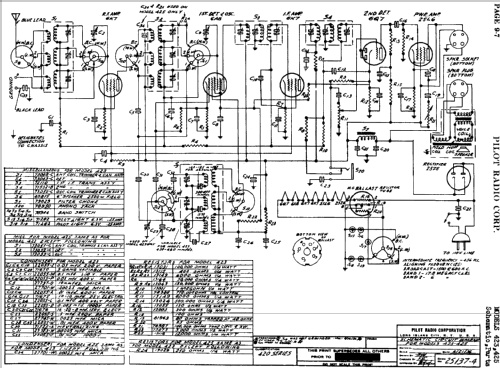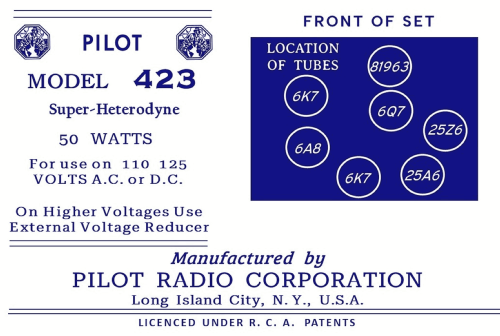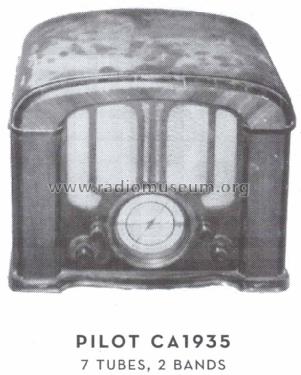- Produttore / Marca
- Pilot Electric Mfg. Co. (Radio Corp.); Brooklyn (NY)
- Anno
- 1936
- Categoria
- Radio (o sintonizzatore del dopoguerra WW2)
- Radiomuseum.org ID
- 51807
-
- alternative name: Pilot Radio & Television || Pilot Radio and Tube || Pilot Radio Corporation
Clicca sulla miniatura dello schema per richiederlo come documento gratuito.
- Numero di tubi
- 6
- Numero di transistor
- Semiconduttori
- 81963
- Principio generale
- Supereterodina con stadio RF; ZF/IF 456 kHz
- N. di circuiti accordati
- 9 Circuiti Mod. Amp. (AM)
- Gamme d'onda
- Onde medie (OM) e 2 gamme di onde corte (2 x OC).
- Tensioni di funzionamento
- Alimentazione universale (doppia: CC/CA) / 110-125 Volt
- Altoparlante
- AP elettrodinamico (bobina mobile e bobina di eccitazione/di campo) / Ø 6 inch = 15.2 cm
- Materiali
- Mobile in legno
- Radiomuseum.org
- Modello: 423 - Pilot Electric Mfg. Co. Radio
- Forma
- Soprammobile con qualsiasi forma (non saputo).
- Dimensioni (LxAxP)
- 15.5 x 13.5 x 11 inch / 394 x 343 x 279 mm
- Annotazioni
-
The Pilot model 423 is an AC/DC operated 6 tube BC and SW band receiver. Uses ballast tube 81963.
The Stein book "Cathedral & Tombstone Radios" reference lists this model as having 2 bands, however the Riders schematic indicates that this model has the BC band and 2 SW bands. The Riders schematic can be confusing as it is applicable for models 423 and 425. Both models have 3 bands, however model 423 has the BC band and 2 SW bands, while model 425 has the BC band, the LW band and just 1 SW band.
- Fonte esterna dei dati
- Ernst Erb
- Fonte dei dati
- Collector's Guide to Antique Radios 4. Edition
- Letteratura / Schemi (1)
- Cathedral & Tombstone Radios (page 197.)
- Letteratura / Schemi (2)
- Rider's Perpetual, Volume 9 = 1938 and before (Pages 9-7, 9-8)
- Altri modelli
-
In questo link sono elencati 544 modelli, di cui 273 con immagini e 412 con schemi.
Elenco delle radio e altri apparecchi della Pilot Electric Mfg. Co. (Radio Corp.); Brooklyn (NY)




